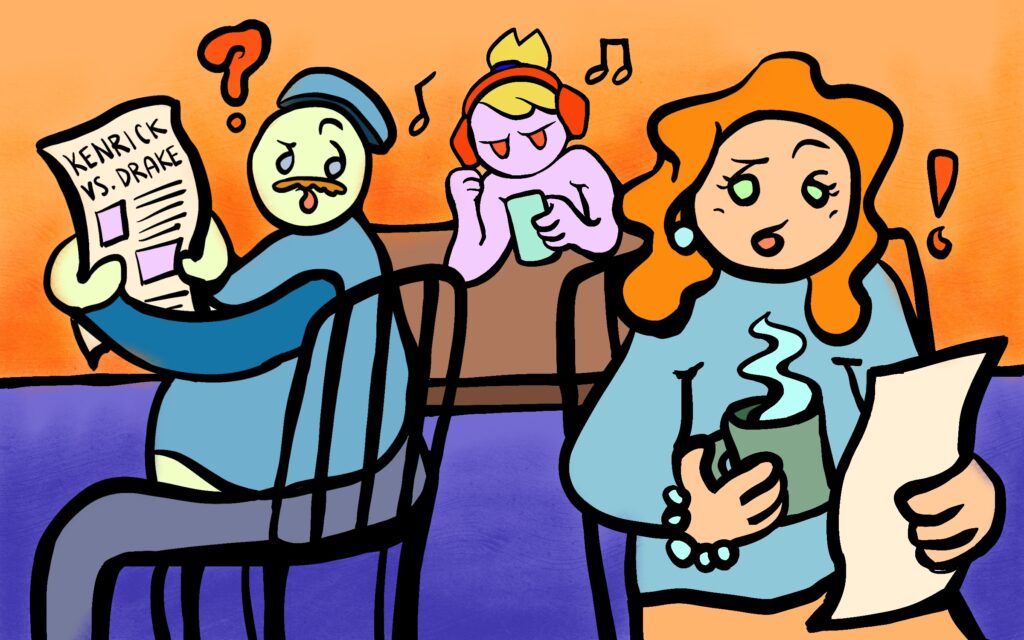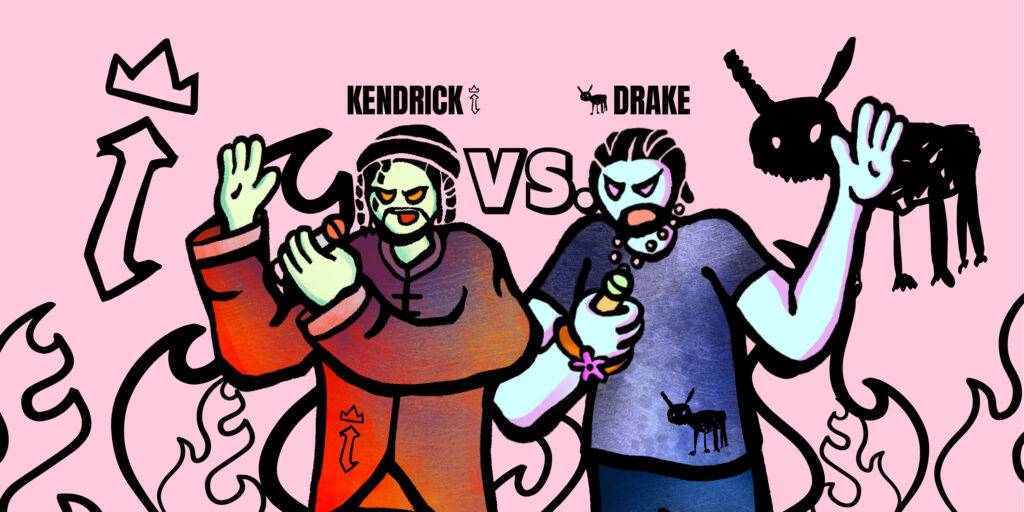Rappers Drake and Kendrick Lamar’s feud felt almost like it started with an inextricable bang and ended with a dull murmur. Everyone resides in the aftermath wondering if this is just a mere ceasefire – a pause before the next clash. But – and I’m just going to speak for everyone here — a fortune teller couldn’t have predicted what our ears heard.
In the spirit of speaking for oneself, when I first heard on the interwebs that the beef consisted of diss records and mixtapes addressing the other, I was elated. I believed it would be a cinematic choreographed fight scene of the lyrical kind. Bruce Lee with his spinning-back-kicks-leaping-several-feet-in-the-air-type of lyrical affair. Very rarely do artists and entertainers have a clean means of deciding who is better. But this was the closest. This battle would be a clean fight to decide who was this generation’s biggest star. I was greatly mistaken.
What the world received instead was a street fight-centered brawl. With all the eye-gouging, below-the-belt hitting, cheap shot-taking that no one could seem to look away from. As record after record dropped, many — me included — lost the enthusiasm to listen to the next released snippet of music. Our cathartic appetite had been filled by the first song from each respective rapper. Although the wordplay and lyrical understanding of the two harkened back to their respective primes, many wished it focused on something more productive. And far less adversarial.
The one takeaway from this conflict of verses: Both artists’ wordplay and lyrical acumen harkened back to their respective primes. Drake, ghostwriting jokes aside, sounded more hungry and artistically polished than he had in more recent projects. Instead of playing it safe, he seemed more apt to take risks with different styles, flows, and imagery. On the other hand, many were delighted to see Kendrick returning to the mainstream, albeit for not-so-righteous purposes, but at least a long-awaited return to the fans, providing the caliber of art he’s most known for. These swirling thoughts raise an interesting question: Does this form of competition among artists truly breed the greatness that their fans seek?
Human beings desperately want to be on the right side of history. Our desire to be informed on an issue where others on the opposing side are ignorant is innate to our condition. And it can lead to conflicts where artists become avatars for the respective ideas, values, and concepts of the masses. Humans, in their desire to see a fair fight, will stoke the conflict in hopes of seeing their artist representing their idea win. And to claim victory for their side in the artistic or intellectual debate.
Now these two concepts run rampant through the stories of both artists. Drake, in many ways, embodies opulence and decadence, with minimal social or political analysis that several upper-echelon black artists find themselves burdened with. He has a history of dating many high-profile and sought-after women, lives in a home that is upwards of 40,000 square feet — the envy of many rap stars, and boasts close to 84 million Spotify monthly listeners. His counterpart Kendrick has spent a vast amount of his discography providing critiques of politics, society at large, and even himself in later work. His music is far more demanding of its listeners than his contemporaries. Kendrick’s body of music is so enamoring he has been the recipient of a Pulitzer Prize, the first rapper to claim that title. For Drake’s gaudy decadence, Kendrick’s lifestyle is more subdued. For every chart-topping Drake record, Kendrick crafts another song to challenge his listeners’ values and morals. Two sides of the same coin represent conflicting concepts; what doors can you open with your talent versus what doors have you opened for others with your talent?
Many onlookers of this beef who are outside of the realm of Gen-Z and Millenials couldn’t understand exactly why this battle seemed to galvanize the airwaves and absorb all the oxygen. I still remember my older family members’ surprise to see the feud even being discussed in newspaper articles. What many fail to realize is these concepts were at war long before Kendrick and Drake were even aware of their musical ability and talent. These timeless concepts ran through every generation’s greatest creative minds. And the war of two clashing creatives is more intriguing to watch than just two famous individuals going back and forth.

Drake and Kendrick are often seen as the contemporary Michael Jackson and Prince, respectively. Both late artists dealt with many of the same themes and overarching conflicts that were bigger than both musicians. Jackson was a chart-topping record-breaking artist, who broke the color barrier and set the standard for many American artists black and white. Prince was an enigmatic musician who was the master of several instruments and was an advocate for artists maintaining rights over their music. Both felt as though they had a claim to the title of best artist of the ’80s and their discographies and histories are riddled with subtle disses towards each other.
Moving away from the realm of music, two other lyrical geniuses also have had a much-publicized feud. Ernest Hemingway and F. Scott Fitzgerald are cited as some of the greatest literary minds of the 1920s. Several critiques by both on the other’s body of work soured their once solid friendship. An utter shame to think about, given the fact both storytellers’ key focuses were literary discussions about masculinity and the forces that drive it.
If we take a broader view, we see visual artists struggle with the very same drive to compete with others. None other than the two most influential artistic intellects in Western Civilization, Michelangelo and Leonardo Da Vinci battled over who could claim the title of “Italy’s greatest artist.” Michelangelo and Da Vinci each picked up the chalice and flag of art’s most privileged forms; the painter versus the sculptor. Each utilized the reception they received for their magnificent work as a barometer of the individual art style’s greatness.
It’s integral to not misinterpret the words I am saying. I am, in no way, saying that skirmishes between artists are okay or acceptable. Let alone for the art as a whole. Rapper and actor Vince Staples made clear, in his way, that he felt the beef between Drake and Kendrick was counterproductive. And in all fairness, he isn’t wrong in his assessment. Artists across the board, of various genres are struggling to make their dreams come true. They are facing rampant calls and criticisms that their work is indoctrinating children, struggling just to get the exposure necessary to at least pay for bare necessities. Even before all of this, would-be artists are being stifled and stopped from entertaining their passion by many state governments who are apt to remove funding for arts from the curriculum of many educational institutions, when you are a parent of a child who exclaims, he/she/they “wants to be an artist when they grow up.” No one would blame you for trying everything in your power to steer them toward a more “suitable-sustainable career.” So, it is pivotal for those who have made a way to make their art forms profitable and marketable, to create new opportunities so others can exercise those same privileges.
The idea is that conflicts between artists are almost inevitable, especially once they’ve moved beyond being “starving” artists to become successful. The human desire to showcase your skills is insatiable and can be gnawing. This is intensified by the public’s increased access to artists today. The drive to secure a top place in history can lead to focusing on proving oneself rather than helping future generations avoid similar struggles.
Does artistic competition breed greatness? A resounding yes. We may never have gotten the iconic song Bad (sing it: Because I’m bad, I’m bad, shamone) if it wasn’t for the Prince v. Jackson feud. Western civilization may never have been blessed by Michelangelo’s David if it wasn’t for the feud he had with Da Vinci. And we may never have enjoyed Hemingway’s last work The Garden of Eden without some elements of Fitzgerald’s analysis of unconventional relationships, that Hemingway initially despised. And despite the depravity and the darkness of each track, if not for what has been deemed the “Rap Civil War,” we may never have known the wordplay of Euphoria and the playing of concepts by Drake in Family Matters. Though oftentimes it isn’t pretty or elegant, and fans get swept up in the negativity and taking sides with their respective favorite creative, we haven’t developed a cure for this human defect — of needing conflict to truly stretch and see how great we are.
I suppose we, as the unartistic collective, will merely have to sit back and wait to see if this will be rectified and remedied. While simultaneously enjoying pretending to hate the work we see and reveling in its beauty and form. Until any change begins to occur, you can find me listening to Marvin Gaye, and also questioning “What’s Going On?”•




